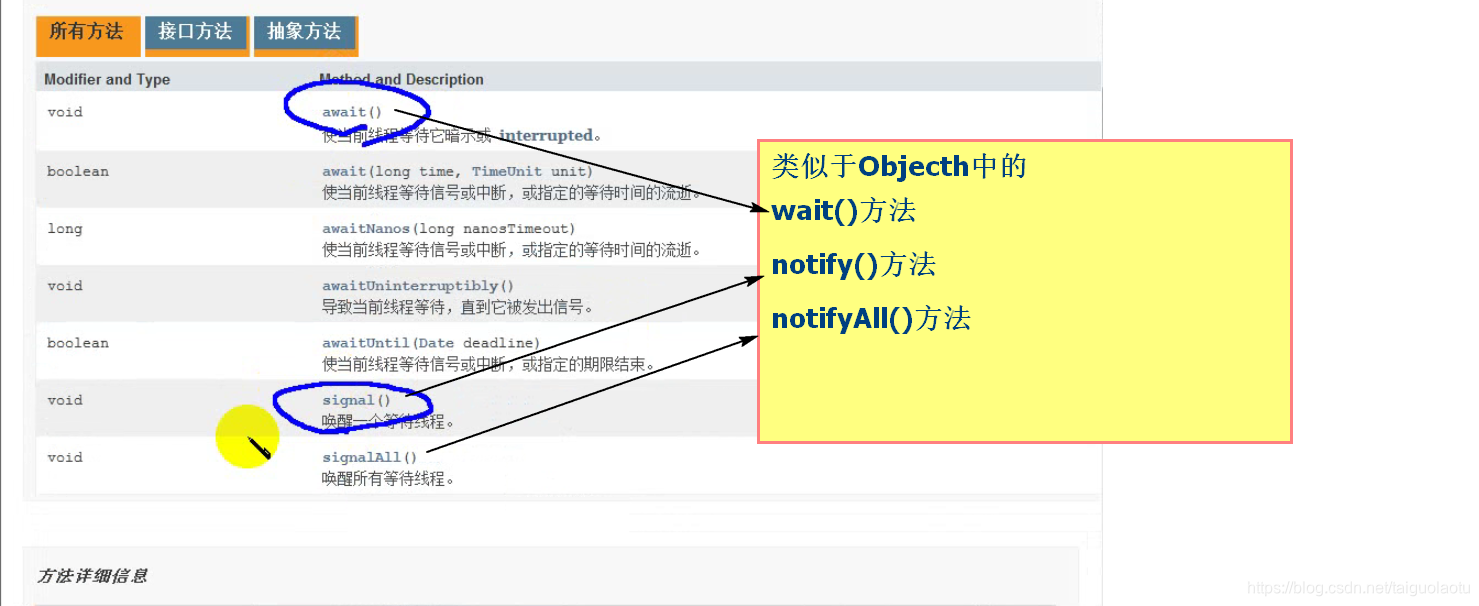代码
public class TestProducerConsumer {
public static void main(String[] args) {
MyStack stack = new MyStack();
Runnable task1 = new Runnable(){
public void run(){
for(char c = 'A' ; c<='Z' ; c++){
stack.push(c+"");
}
}
};
Runnable task2 = new Runnable(){
public void run(){
for(int i = 1 ; i <= 26; i++){
stack.pop();
}
}
};
new Thread(task1).start();
// new Thread(task1).start();
// new Thread(task2).start();
new Thread(task2).start();
}
}
class MyStack{
String[] data = {"","","","","",""};
int index;
public synchronized void push(String s){
while (data.length == index) {
try {
this.wait();
} catch (InterruptedException e) {
e.printStackTrace();
}
}
System.out.print(s + " pushed ");
data[index] = s;
index++;
print();
this.notifyAll();//只要执行生产者(数组中增加元素)就要通知消费者
//释放消费者线程,但是不释放锁标记。这个同步方法执行完毕,会
//释放锁标记
}
public synchronized void pop(){
while (index == 0) {
try {
this.wait();
} catch (InterruptedException e) {
e.printStackTrace();
}
}
index--;
String o = data[index];
data[index] = "";
System.out.print(o + " poped ");
print();
this.notifyAll(); //只要执行消费者(将数组中元素进行出栈) 就会通知生产者
//释放生产者线程 ,但是不释放锁标记。这个同步方法执行完毕,会
//释放锁标记
}
public void print(){
for(int i = 0 ; i < data.length ; i++){
System.out.print(data[i]+" ");
}
System.out.println();
}
}
执行结果
A pushed A
B pushed A B
B poped A
A poped
C pushed C
D pushed C D
E pushed C D E
F pushed C D E F
G pushed C D E F G
H pushed C D E F G H
H poped C D E F G
G poped C D E F
F poped C D E
E poped C D
D poped C
C poped
I pushed I
I poped
J pushed J
J poped
K pushed K
K poped
L pushed L
M pushed L M
M poped L
L poped
N pushed N
O pushed N O
O poped N
N poped
P pushed P
P poped
Q pushed Q
R pushed Q R
S pushed Q R S
T pushed Q R S T
U pushed Q R S T U
V pushed Q R S T U V
V poped Q R S T U
U poped Q R S T
T poped Q R S
S poped Q R
R poped Q
Q poped
W pushed W
X pushed W X
Y pushed W X Y
Z pushed W X Y Z
Z poped W X Y
Y poped W X
X poped W
W poped
代码
public class TestNumberCharPrint {
public static void main(String[] args) throws InterruptedException {
final Object o = new Object();
Runnable task1 = new Runnable(){
public void run(){
synchronized (o) { //同一个o对象
for (int i = 1; i <= 52; i++) {
System.out.print(i);
if (i % 2 ==0){
o.notifyAll();//释放字母线程
try {
if(i!=52) o.wait(); //同一个等待队列
} catch (InterruptedException e) {
e.printStackTrace();
}
}
}
}
}
};
Runnable task2 = new Runnable(){
public void run(){
synchronized (o) { //同一个o对象
for (char c = 'A'; c <= 'Z'; c++) {
System.out.print(c);
o.notifyAll();//释放数字线程
try {
if (c!='Z') o.wait(); //同一个等待队列
} catch (InterruptedException e) {
e.printStackTrace();
}
}
}
}
};
Thread t1 = new Thread(task1);
Thread t2 = new Thread(task2);
t1.start();
Thread.sleep(1);
t2.start();
}
运行结果
12A34B56C78D910E1112F1314G1516H1718I1920J2122K2324L2526M2728N2930O3132P3334Q3536R3738S3940T4142U4344V4546W4748X4950Y5152Z
Lock代码
//jdk5.0中synchronized不用的情况下
public class TestProducerConsumer {
public static void main(String[] args) {
MyStack stack = new MyStack();
Runnable task1 = new Runnable(){
public void run(){
for(char c = 'A' ; c<='Z' ; c++){
stack.push(c+"");
}
}
};
Runnable task2 = new Runnable(){
public void run(){
for(int i = 1 ; i <= 26; i++){
stack.pop();
}
}
};
new Thread(task1).start();
new Thread(task1).start();
new Thread(task2).start();
new Thread(task2).start();
}
}
class MyStack{
String[] data = {"","","","","",""};
int index;
Lock lock = new ReentrantLock(); //锁对象
//jdk5.0使用condition对象实现生产者消费者代码
Condition full = lock.newCondition(); //通过锁对象获取Condition对象 获得等待队列 生产者
Condition empty = lock.newCondition(); //获得等待队列 消费者
public void push(String s){
try {
lock.lock(); //替换synchronized 作用一样都是(标记同步代码快) 进入同步代码快
while (data.length == index) {
try {
full.await(); //等同于 Object类中wait()方法
} catch (InterruptedException e) {
e.printStackTrace();
}
}
System.out.print(s + " pushed ");
data[index] = s;
index++;
print();
empty.signalAll();//通知消费者 等同于 Object类中notifyAll()方法
}
finally{
lock.unlock(); //离开同步代码块
}
}
public void pop(){
try {
lock.lock();
while (index == 0) {
try {
empty.await(); //释放线程 同时释放对象锁标记
} catch (InterruptedException e) {
e.printStackTrace();
}
}
index--;
String o = data[index];
data[index] = "";
System.out.print(o + " poped ");
print();
full.signalAll(); //通知生产者 释放线程 不释放对象锁标记
}
finally{
lock.unlock();
}
}
public void print(){
for(int i = 0 ; i < data.length ; i++){
System.out.print(data[i]+" ");
}
System.out.println();
}
}

这辈子坚持与不坚持都不可怕,怕的是独自走在坚持的道路上!





















 2624
2624











 被折叠的 条评论
为什么被折叠?
被折叠的 条评论
为什么被折叠?








